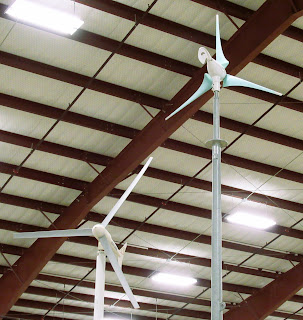Museums come in all types: art, science, technology, inventions, history, geology, you name it. You never know what a museum holds until you step onto its grounds, explore its exhibits, and open your curious mind to what you find inside. Websites give information about what you will see, but typically you will discover more than you thought. We experienced this today at the American Windmill Museum AKA The American Wind Power Center.
The American Windmill Museum is the largest windmill museum in the world. It sits on 28 acres of city parkland east of Lubbock, Texas. The hours are Tuesday through Saturday, 10 am to 5 pm; closed Sunday and Monday.
 |
| There's all this and more! |
 |
| Windmill art on the entry door! |
 |
| A hand-carved rocking chair decorated with a roadrunner. |
We arrived at 10:30 am and entered the building to pay, but no one was at the reception window. After helping ourselves to a snack-size piece of candy and a small bottle of water, we picked up the brochures on the table and signed the guest book. The windmill exhibits outside looked inviting, so we checked them out. We'd go in and pay when we came back around to the front.
The outside exhibits are what convinced us we had to come to this museum when we saw the grounds a year ago. It was too late in the day for us to visit then. Now we have returned!
"How does a windmill work? The windmill is erected on a tall tower above any obstructing objects like trees or houses. When the wind hits the wheel, it begins to turn gears inside the gearbox which changes the rotating motion of the wheel into an up-and-down pump stroke. A wooden sucker rod connects the gears to a pump cylinder located at the bottom of the well. Water is then lifted to the surface where it can be stored in stock tanks or in domestic water tanks. The tail on the windmill points the wheel into the wind."
Things to notice on the windmills:
- Unique color schemes for each windmill manufacturing company.
- Orienting tails (with or without advertising as shown below).
- Windmill weights for windmills without orienting tails could be
- distinctive figure weights [there will be photos below],
- governing weights, or
- crescent weights (with the tips pointing up) [there will be photos in Part 2].
 |
| Bob at the base of a Platner- Yale Mfg. Co. windmill from Lincoln, Nebraska (1916). |
 |
| A cluster of windmills. |
"Challenge windmills: Challenge made and sold thousands of the Model 27 windmills on the Great Plains. Big windmills, like this 20-ft. model, pumped water for large cow herds in Texas. The wheel mounted on a 4,000-pound gearbox and stood on a 40-ft. steel tower."
 |
| S-Challenge, Batavia, Illinois. |
Vestas V47 statistics: The wheel is 155 ft. in diameter. The steel tower is 165 feet in height. In the Lubbock winds this turbine, rated at 660 kilowatts, will generate over 800,000 kilowatt hours each year. The wind turbine is big enough to completely power the entire museum complex.
 |
| Vestas V47 (2005), Vestas American Wind Technology |
 |
| There were even windmills in the sidewalk! |
"A 10-ft. 602 Aermotor pumps water from a well that is 127-ft. deep. The water flows through a pipe to the large stock tank just south of the Flowerdew Hundred Post Mill."
 |
| The large stock tank is filled with koi and other fish. |
 |
| An awesome gate by the Flowerdew Hundred Post Mill. |
 |
| The two huge museum buildings that house the exhibits. |
It's fun to explore and marvel at the huge windmills and the wind turbine on the 28 acres. New-to-us windmills included the twin-wheel windmill from 1925 and the Flowerdew Hundred Post Mill.
"A unique monopole tower (1920) was built for an Aermotor windmill by Ted Russell of Vera, Texas. He had enough money to buy the windmill, but not the tower. He used an oil field pipe for the monopole tower which had a bend in it to clear the sucker rod." (I took a video of this monopole tower working, but it didn't turn out well. You'll just have to imagine it.)
Twin-wheel (1925) from the Twin Wheel Windmill Manufacturing Company in Hutchinson, Kansas:
"The twin wheel is a very unusual American windmill. It has two 12-ft. wheels that counter-rotate and drive a single sucker rod. Advertised as 'pumping twice as much water from a single well,' these were powerful when working." In fact, an inside video about these windmills said that one small town installed a twin-wheel and within six hours it sucked their well dry!!!
 |
| Twin-wheel windmill. |
"Flowerdew Hundred Post Mill (1621):
 |
 |
| The Zephyr from Tokyo, Japan is the light green wind turbine above. WinPower from Ningbo, China is white. |
 |
| The design of WinGEN. |
4. There was one last wind turbine in that exhibit and it looked completely different. I asked the docent about it. Apparently, the Honeywell Windtronics wind turbine was a dud. "This machine never produced a single watt of electricity."
- Sunflower Windmill, Sunflower Windmill Company, Topeka, Kansas. (1890)
 |
| The Sunflower Windmill. |
- Dempster #10, Dempster Mill Manufacturing Company, Beatrice, Nebraska. (Manufactured between 1914 and 1925).















Did they tell you how important the women were in operating the early mills or even lubricating them and about tying down the vanes in order to do so?
ReplyDeleteDJ, I don't remember an emphasis on women lubricating the windmills, but I do remember a display about how hard it was to lubricate them. There is a plethora of information in this museum and it's hard to retain all of it; although I take a lot of photos to try. ~Susan
Delete